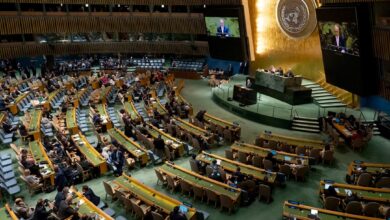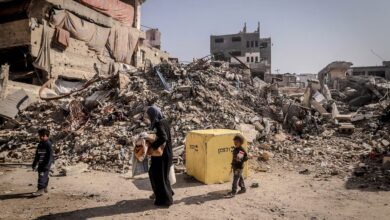“To exist is to resist”—a theme heavily echoed throughout William Parry’s provocative book, “Against the Wall: The Art of Resistance in Palestine.” Consisting mainly of photographs supported by some reports, observations and personal accounts, “Against the Wall” is a record of the 2007 collaboration orchestrated by London-based organization Pictures on Walls and notorious British graffiti artist Banksy, which saw a team of international street artists travel to Bethlehem in an attempt to bring awareness to the West Bank Wall being built by the Israeli government. The artists gradually turned a monument of tyranny into a “giant billboard” of protests, political statements, cries of condemnation, words of support and messages of hope.
Graffiti has long been the art form of the oppressed; for those who feel their basic human rights have been forsaken, what better method of non-violent expression than the violation of public property in the name of personal protest? As Parry explains early on, the works of Banksy and his army of street artists “only account for a modicum” of the total graffiti covering the barrier. “Against the Wall” also serves as a gallery of artwork of an imprisoned people which, while generally less skilled than the professional work, still comes across as being clearly and painfully heartfelt.
The photographs in the book are not limited to graffiti, with Parry devoting an equal amount of “Against the Wall” to images depicting how various villages and their inhabitants have deteriorated in the shadow of the separation barrier. Images of desolate ghost towns, boarded-up houses, and buildings in ruin are common throughout the book, with the graffiti-covered wall in the background serving as a running commentary. ‘“The only peace Israel wants is a piece of my land,” one section of the wall reads, while on another, a Jewish organization against the construction of the barrier poses the question, “Israel–have you become the evil you deplored?”
The images in "Against the Wall" are simultaneously heart wrenching and strangely uplifting. Few things are as inspiring as resilience in the face of injustice, and the images of assorted graffiti in this book capture this spirit in every possible manifestation, from anger and bitterness to undying optimism and even mockery. Take, for example, the restaurant owner who painted an 8-meter-high menu on the concrete slabs and set up tables for customers alongside it, incorporating the wall into his business. Throughout the book—and in spite of the reality of the local artists’ daily lives—there is not a single hint of submission.
Despite its reliance on imagery rather than text, “Against the Wall” is still an extremely informative and well-written book, with Parry’s journalistic approach simple yet revealing. Regardless of the reader’s stance on the divisive Israeli-Palestinian conflict, only the truly heartless will fail to be moved by the real-life accounts included within—tragic tales of the victims of a seemingly endless and clearly lopsided struggle. Throughout the book, Parry chronicles his tour of the enclosed region, using personal observations to provide a vivid, thorough measure of the economic, social and physical isolation enforced by Israel’s separation barrier. Besides the numerous accounts of divided families and crippled businesses, some stories are difficult to read; the brutality they describe is nearly incomprehensible to an outsider.
In one instance, a doctor recalls watching a one-day-old baby die in an ambulance that was not allowed access to a hospital outside of the wall, simply due to an Israeli guard’s insistence on “seeing the newborn’s ID.” Another section deals with guilt-ridden Palestinians who, because of the restrictions brought by the barrier, have no income other than through construction work on the wave of luxurious Jewish settlements illegally encroaching on their homeland. Parry includes several pages of images showing the daily humiliation endured by the workers and any other West Bank resident trying to pass through the wall’s security points. From being forced to show up half a day in advance for a gate that will stay open for two hours, regardless of the amount of people waiting to pass through, to sleeping on the ground, to being lined up and literally crowded into in cages–there is no misinterpreting these photos.
Nor is there any chance of misinterpreting the facts printed in “Against the Wall,” with many of them taken directly from reports from the United Nations and various human rights organizations which, despite the lack of action taken, are still involved enough to point out the many violations which the barrier represents, both legally and in terms of human rights. “Against the Wall” is not just a photo book; it is an indictment against an injustice of monstrous proportions; and a testament to the spirit of resistance strong enough to find creativity in the face of it.




